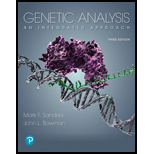
Go to the OMIM website (https://www.ncbi.nlm.nih.gov/omim) and type “dyskeratosis congenital autosomal dominant 1” (DKCA1) into the search bar. The result will include a clickable link to the disorder that has an OMIM number of
Go the reference number
a. How do telomere lengths in children compare with telomere lengths of their parents?
b. Why are telomeres of people with DKCA
Want to see the full answer?
Check out a sample textbook solution
Chapter 7 Solutions
Genetic Analysis: An Integrated Approach (3rd Edition)
- Compare the cloning efficiencies: SmaI vs. EcoRI.arrow_forwardHydrogen bonds play an important role in stabilizing and organizing biological macromolecules. Consider the four macromolecules discussed. Describe three examples where hydrogen bond formation affects the form or function of the macromolecule.arrow_forwardImagine you are a botanist. Below are characteristics of a never-before described plant species recently identified as part of the ‘All Taxa Biodiversity Inventory’ (ATBI). Field Notes: Specimen collected from shaded area along stream in South Cumberland State Park (Grundy County, TN). Laboratory Analysis: Body: Large leaves emerging from underground rhizome. Size: 63 cm Chromosomal Analysis: Plant body is diploid—chromosome number of 44. Lignin test: Positive Cuticle: Present Leaves: Present—large with branched veins. Underside has sori (containing haploid spores). Roots: Present—branch from the inside. Stem: Present—vascular tissue (xylem & phloem) present. Life History: Diploid sporophyte dominant generation. Haploid spores germinate into heart-shaped, haploid, gametophyte. Water required for fertilization; no seed is produced. Diploid zygote develops into sporophyte. Explain which domain, kingdom and phylum you believe this plant should be classified…arrow_forward
- CUÁ Glycine A C C Newly formed molecule Glycine Arginine Proline Alanine A C C CC G GGAUUGGUGGGGC Structure X I mRNAarrow_forwardAdaptations to a Changing Environment Why is it necessary for organisms to have the ability to adapt? Why is the current environment making it difficult for organisms like the monarch butterfly to adapt? Explain how organisms develop adaptations.arrow_forwardArtificial Selection: Explain how artificial selection is like natural selection and whether the experimental procedure shown in the video could be used to alter other traits. Why are quail eggs useful for this experiment on selection?arrow_forward
- Don't give AI generated solution otherwise I will give you downwardarrow_forwardHello, Can tou please help me to develope the next topic (in a esquematic format) please?: Function and Benefits of Compound Microscopes Thank you in advance!arrow_forwardIdentify the AMA CPT assistant that you have chosen. Explain your interpretation of the AMA CPT assistant. Explain how this AMA CPT assistant will help you in the future.arrow_forward
 Human Heredity: Principles and Issues (MindTap Co...BiologyISBN:9781305251052Author:Michael CummingsPublisher:Cengage Learning
Human Heredity: Principles and Issues (MindTap Co...BiologyISBN:9781305251052Author:Michael CummingsPublisher:Cengage Learning
